Archive:Agriculture - rural development statistics
- Data from February 2013. Most recent data: Further Eurostat information, Main tables and Database.
Rural development is an important policy area, covering areas such as: farming and forestry; land use; the management of natural resources; and economic diversification in rural communities. Rural areas are important to the European economy insofar as they provide a wide range of foodstuffs and raw materials. Furthermore, rural areas are generally places of natural beauty and offer a wide range of recreational activities, while forested areas provide one means of combating climate change.
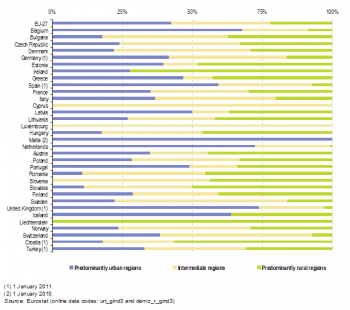
(% of total population) - Source: Eurostat (urt_gind3) and (demo_r_gind3)
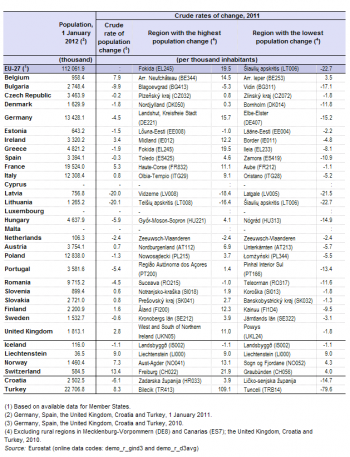
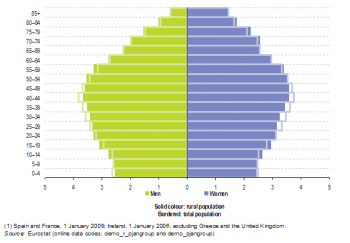
(% of total population) - Source: Eurostat (demo_r_pjangroup) and (demo_pjangroup)
(% of the EU-27 average, EU-27=100) - Source: Eurostat (demo_r_pjanaggr3)

(%) - Source: Eurostat (demo_r_pjanaggr3)
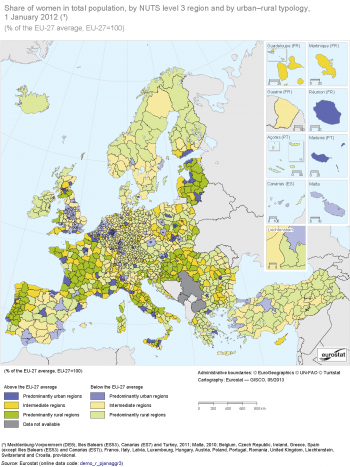
(% of the EU-27 average, EU-27=100) - Source: Eurostat (demo_r_pjanaggr3)
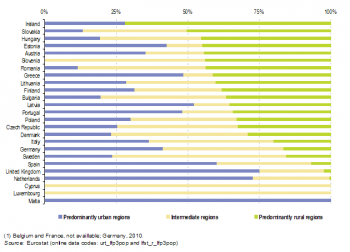
(% of active population) - Source: Eurostat (urt_lfp3pop) and (lfst_r_lfp3pop)
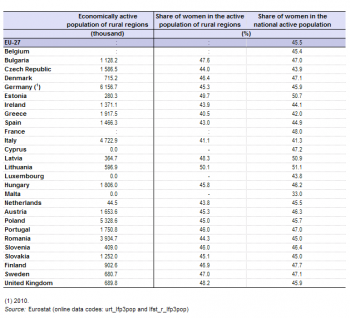
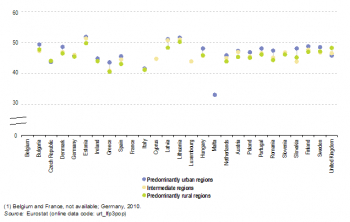
(% of active population) - Source: Eurostat (urt_lfp3pop)
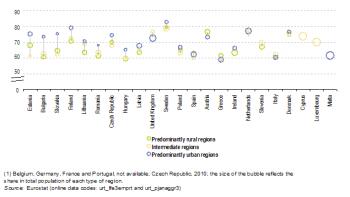
(%) - Source: Eurostat (urt_lfe3emprt) (urt_pjanaggr3)
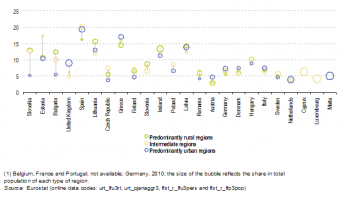
(%) - Source: Eurostat (urt_lfu3rt), (urt_pjanaggr3), (lfst_r_lfu3pers) and (lfst_r_lfp3pop)
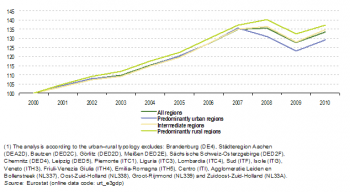
(2000=100) - Source: Eurostat (urt_e3gdp)

(% share of total value added) - Source: Eurostat (nama_r_e3vab95r2)

(% share of total employment) - Source: Eurostat (nama_r_e3emp95r2)
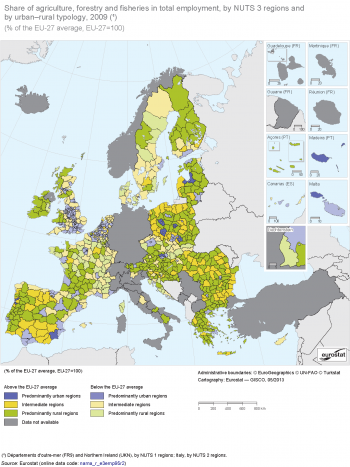
(% of the EU-27 average, EU-27=100) - Source: Eurostat (nama_r_e3emp95r2)
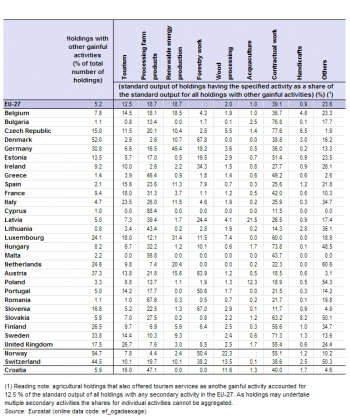

(% of standard output for all agricultural holdings) - Source: Eurostat (ef_ogadsexage)
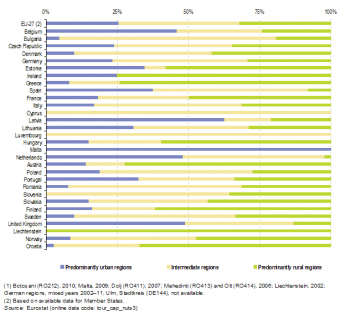
(% of total number of bed places) - Source: Eurostat (tour_cap_nuts3)

(% of the EU-27 average, EU-27=100) - Source: Eurostat (tour_cap_nuts3)
In contrast, many of the European Union’s (EU’s) rural areas face a common challenge — namely, their capacity to create high-quality, sustainable jobs has fallen behind that of urban areas. Generally, incomes are lower in rural regions than in towns or cities and there are fewer job opportunities and these are in a narrower range of economic activities. These differences between regions have, in some cases, resulted in land abandonment and considerable outward flows of rural populations. This article highlights the structure of rural populations, developments within rural labour markets, and an analysis of economic activity in rural areas between the primary sector (dominated by agriculture and forestry) and the tertiary sector (where tourism plays an increasingly important role).
Main statistical findings
More than half (51.3 % in 2012) of the EU’s land area is within regions classified as being predominantly rural; these areas were inhabited by 112.1 million people, more than one fifth (22.3 %) of the EU-27’s population. Just under two fifths (38.7 %) of the area and more than one third (35.3 %) of the EU’s population were living in intermediate regions in 2012, while predominantly urban regions made up just one tenth (10.0 %) of the land area but accounted for more than two fifths (42.4 %) of the population.
These three types of region are defined according to an urban-rural typology which classifies each NUTS level 3 region to one and only one of the three types of region; Map 1 shows which regions fall into each of the three types. It should be noted that as population levels and population density change over time regions can move from one type to another, which can also happen if regional boundaries change. The analyses presented in this article are based on a recent revision of the typology using the NUTS 2010 classification.
Among the EU-27 Member States, Cyprus, Luxembourg and Malta do not have any predominantly rural regions: Cyprus and Luxembourg have only one NUTS level 3 region each and in both cases this is classified as intermediate; Malta has two NUTS level 3 regions both of which are classified as predominantly urban regions. Ireland has only predominantly urban regions and predominantly rural regions but no intermediate regions, while Slovenia has no predominantly urban regions. All of the other 22 Member States have at least one NUTS level 3 region in each of the three urban–rural region types.
Focus on the population in predominantly rural regions
A summary of the distribution of the population between the three types of regions as of the start of 2012 is presented in Figure 1. Although the average share of the population in predominantly rural regions was 22.3 % in the EU-27, the share in most Member States was higher than this: the EU-27 average was strongly influenced by low shares in some of the largest Member States, notably the United Kingdom (2.9 %, 1 January 2011), Spain (7.4 %, 1 January 2011), Germany (16.4 %, 1 January 2011) and Italy (20.2 %) — as well as to a lesser extent by the Netherlands (0.6 %), Belgium (8.6 %) and Sweden (16.2 %). Of the five largest (in population terms) Member States, France was the only one with a share (29.9 %) of the population in predominantly rural regions that was above the EU-27 average. The highest share of the population living in predominantly rural regions was recorded for Ireland (72.4 %). A relatively large proportion of the population lived in predominantly rural regions in many of the central and eastern European countries that joined the EU in 2004 or 2007, ranging from close to one third of the population in the Czech Republic and Poland to more than a half (50.3 %) in Slovakia; also falling within this range were Austria, Greece, Finland and Portugal.
The four EFTA countries had very different population structures according to this typology. Liechtenstein is composed solely of a predominantly rural region, whereas predominantly rural regions in Switzerland were home to just 7.3 % of the population. The proportion of the population in predominantly rural regions was above the EU-27 average in each of Iceland (36.3 %) and Norway (29.3 %); this was also the case in the acceding and candidate countries for Turkey (30.8 %) and to a much greater extent for Croatia (56.7 %).
Population change
Predominantly rural regions in the EU-27 have experienced limited population growth or decline in recent years. In 2008 and 2009 predominantly rural regions in the EU-27 recorded growth of 0.2 % and 0.1 %, whereas intermediate and predominantly urban regions both recorded growth between 0.4 % and 0.7 % — predominantly urban regions growing slightly faster than intermediate regions. In 2010, the EU-27’s population in predominantly rural regions remained unchanged and then fell by 0.1 % in 2011, while in both years intermediate regions recorded growth of 0.2 % and predominantly urban regions growth of 0.5 %.
The most recent population and population change information for predominantly rural regions is provided in Table 1 — generally the data is for 1 January 2012 but in some cases it refers to 1 January 2011. France had by far the largest population in predominantly rural regions, a total of 19.5 million persons, equivalent to 17.4 % of the EU-27 total. Germany, Poland, Italy and Romania had the next largest populations in predominantly rural regions and together with France these five Member States were home to 60.5 % of the EU-27’s population in predominantly rural regions.
Predominantly rural regions experienced growth in 2011 in nine EU Member States (as well as in the United Kingdom in 2010); most of these were EU-15 Member States, although the population of predominantly rural regions also grew in Slovakia and Slovenia. The strongest population growth in predominantly rural regions was recorded in Belgium (7.9 per thousand) and France (5.3 per thousand). By contrast, the sharpest declines in population in predominantly rural regions were recorded in Lithuania (-20.1 per thousand) and Latvia (-20.0 per thousand), followed at about half this rate by Bulgaria (-9.9 per thousand). Among the EU-15 Member States, Portugal recorded the fastest decline in the population of predominantly rural regions, down 5.4 per thousand, ahead of Germany (2010) where the population fell by 4.5 per thousand.
At a more detailed level, there were contrasting developments in most Member States, except for the Netherlands which had just one predominantly rural region (where the population fell). In nearly every Member State there was at least one NUTS level 3 region with falling rural population; Belgium was the only exception, with all predominantly rural regions experiencing population growth. Equally there were some predominantly rural populations that grew in each of the Member States, other than in the Baltic Member States, Bulgaria and Romania. Across the whole of the EU, the predominantly rural region with the fastest population growth in 2011 was Fokida in Greece, where the population rose by 19.5 per thousand, while the fastest population decline was reported for Šiauliu apskritis in Lithuania (-22.7 per thousand).
Among the EFTA countries, all predominantly rural regions except for the one Icelandic region recorded population growth in 2011, with growth reaching 21.9 per thousand in Freiburg, Switzerland. Overall Croatia’s predominantly rural regions recorded a decline in population whereas those in Turkey experienced growth. The regional variation in Turkey was extremely large, from a decline of 79.6 per thousand in Tunceli in eastern Anatolia to growth of 109.1 per thousand in Bilecik close to the Marmara Sea.
Population structure
When compared with the total population, the population in predominantly rural regions tends to have less people of working age, more older people, and more young people aged 10–19. This general pattern can be seen for men and women — see Figure 2. Among the working age population the difference between predominantly rural regions and the total population was most notable between the ages of 25 and 49 for women and between 30 and 59 for men. Among older people the differences were most notable for the age groups between 70 and 84 for women and from 75 upwards for men.
It is projected that consistently low birth rates and higher life expectancy will transform the shape of the EU-27’s age pyramid in the coming decades. Probably the most important change will be the marked transition towards a much older population structure and this development is already becoming apparent in several EU Member States. As a result, the proportion of people of working age in the EU-27 is shrinking while the relative number of those retired is expanding. The share of older persons in the total population will increase significantly in the coming decades, as a greater proportion of the post-war baby-boom generation reaches retirement. This will, in turn, lead to an increased burden on those of working age to provide for the social expenditure required by the ageing population for a range of related services.
Across the EU-27, some 17.8 % of the population was aged 65 or over at the beginning of 2012. The highest share for any region in 2012 was 33.9 % in the rural Portuguese region of Pinhal Interior Sul. In fact, the 10 regions with the highest shares of persons aged 65 or over included eight that were predominantly rural regions, one intermediate region (Dessau-Roßlau, Kreisfreie Stadt in Germany) and one predominantly urban region (Trieste in Italy). The predominantly rural regions with the highest shares of persons aged 65 or over were concentrated in the centre of Portugal, with one other Portuguese region (Alto Trás-os-Montes) further to the north, two regions in mainland Greece (Grevena and Evrytania) and one in north-western Spain (Ourense). By contrast, the only predominantly rural region among the 10 regions with the lowest share of persons aged 65 or more in the population was the Irish Mid-East region, with a share of 9.3 %: the lowest share among all of the regions was 4.4 % in the French overseas region of Guyane.
Map 2 provides a regional analysis of persons aged 65 and over as of the beginning of 2012, identifying regions by their type and whether the share of persons aged 65 or more was above or below the EU-27 average. Around one third of the regions had shares below the EU-27 average, indicating that these regions were generally larger or had particularly low shares. For all three types of region, the number of regions where the share of persons aged 65 or more was above the EU-27 average was greater than the number where the share was lower. However, for urban regions this difference was relatively small (167 regions above the EU-27 average compared with 149 regions below the average) whereas for the other two types of regions the difference was far greater. In other words, a predominantly urban region was much more likely to have a share of persons aged 65 or more in the population that was below the EU-27 average than were either an intermediate or a predominantly rural region. This observation is reinforced by the information provided in Table 2, where it can be seen that the share of persons aged 65 or more in the population in rural regions was above the national average in all of the EU Member States except for Belgium and Poland. The largest (in percentage point terms) differences between the shares for rural and national populations were observed for the Netherlands (5.5 percentage points), Spain (4.9), Portugal (3.8), France (3.2) and the United Kingdom (3.0). The general pattern of higher shares in rural regions was repeated in Iceland and Norway, but not in Switzerland, where the share of older persons was lower in rural regions; Liechtenstein has only one region and that is rural so the national and rural shares are the same. Equally, both Croatia and Turkey had higher shares of older persons in their rural populations than their national averages.
The old-age dependency ratio — calculated for the purposes of this publication as the percentage ratio of persons aged 65 or more to persons aged 15–64 — was 28.2 % across the rural regions of the EU-27 as of the start of 2012; this can be compared with a 29.2 % ratio for all types of region. The fact that predominantly rural regions had a relatively low old-age dependency ratio but a relatively high share of persons aged 65 or more in their total population suggests that there was a lower share of young people in the population in predominantly rural regions (15.4 %) than across all types of region (21.1 %).
Comparing the national averages for old-age dependency ratios in the rural regions of the EU Member States, these ranged from 36.8 % in Portugal to an average of 17.8 % in Slovakia; the Turkish average was even lower at 12.3 %. As well as these large differences between rural averages for each Member State, there was also a quite diverse range of old-age dependency ratios within the predominantly rural regions of individual Member States — see Table 2. The largest range was reported for Portugal, where there was a 20.6 percentage point gap between the old-age dependency ratios of Pinhal Interior Sul (33.9 %) and the Região Autónoma dos Açores (13.3 %). Differences in excess of 10 percentage points were also observed for Greece, Spain, Germany, France and the United Kingdom, as well as for Turkey.
The share of women in the EU-27’s population was 51.2 %, as of the beginning of 2012. Among the 1 294 NUTS level 3 regions there were 466 regions (just over one third of the total) where the share of women was higher than the EU average. In all three types of regions within the urban–rural typology the number of regions where the share of women in the population was above the EU-27 average was smaller than the number of regions where it was below the average. Nevertheless, relative to the total number of regions of each type, the number of predominantly rural regions where the share of women was above average was relatively low, as 143 out of 482 (29.7 %) predominantly rural regions reported shares of women above the EU-27 average. For intermediate regions there were 189 out of 496 (38.1 %) regions with above average shares of women in the population, while for urban regions above average shares were observed in 134 out of 316 (42.4 %) regions. These figures suggest a flow of women out of predominantly rural regions into predominantly urban regions and/or a movement of men in the other direction.
The highest share of women in the population for any of the NUTS level 3 region was 55.9 % in Riga (Latvia). Shares above 53.0 % were reported for 34 NUTS level 3 regions, spread across nine EU Member States. The majority of these regions with particularly high shares of women in the population were in the Baltic Member States: nine in Lithuania, six in Latvia and five in Estonia (there was a relatively large difference in life expectancy between men and women in these countries). The remaining regions were in Poland (five regions), Germany (four regions), France (two overseas regions), Hungary, Portugal and Romania (one region each). These regions were fairly evenly split between the three types of regions, with 13 of them classified as predominantly rural regions, among which Panevežio apskritis in Lithuania had the highest share of women (54.1 %).
In 133 of the 1 294 regions in the EU-27 men were in the majority, in other words the share of women was less than half. In just 22 regions the share of women was 49.0 % or less, mainly in Greece (13 regions) and Spain (seven regions), with one region each in the Netherlands and the United Kingdom. Most (14) of these regions with particularly low shares of women in the population were predominantly rural regions, with the predominantly rural region of Evros in Greece reporting the lowest share (47.7 %) of all regions.
Focus on the labour market in predominantly rural regions
Economically active population
The distribution of the economically active population by type of region was very similar to the distribution of the population as a whole. As such, the weights of predominantly rural regions in the economically active population aged 25 years or over and in the total population were very close. As Figure 3 shows, the share of the active population in predominantly rural regions varied considerably from country to country: in the Netherlands, the United Kingdom and Spain predominantly rural regions accounted for less than 10 % of the economically active population, while at the other end of the scale predominantly rural regions in Ireland accounted for over 70% of the economically active population.
Women in the labour force
Based on an analysis of the share of women in the labour force (aged 25 or over) it can be seen that, on average, women play a smaller role in the labour force of predominantly rural regions than in the whole economy. This pattern was observed for most EU Member States (Belgium and France, not available; Cyprus, Luxembourg and Malta, no predominantly rural regions) as only Bulgaria, the United Kingdom and the Czech Republic reported a higher share of women in the labour force within predominantly rural regions (than their respective national averages for the whole economy). In the other EU Member States, the differences between national averages and shares for predominantly rural regions were relatively small, only exceeding 1.0 percentage point in Estonia, Greece, Spain, Latvia, Lithuania, the Netherlands, Austria, Portugal, Poland and Romania. However, when compared with the other types of region the share of women in the economically active population in predominantly rural regions was generally lower. Figure 4 shows that only in Bulgaria, the Czech Republic, the United Kingdom and Slovakia was the share of women in the labour force in predominantly rural regions higher than in either of the other two types of region.
Employment and unemployment
Employment rates for persons aged 20–64 in the three different types of regions are presented in Figure 5. In half of the EU Member States for which data are available and which have at least two types of regions, predominantly rural regions generally had a lower employment rate than the other types of regions. In seven EU Member States intermediate regions had the lowest employment rates while in Greece, Spain and Austria predominantly rural regions had a higher employment rate than both intermediate and predominantly urban regions.
In several central and eastern EU Member States the difference between the employment rate in predominantly rural regions and predominantly urban regions was particularly high, notably in Bulgaria (12.8 percentage points difference), as well as Slovakia (10.9), Finland (8.4), Estonia (7.3), Lithuania (7.1), Hungary (5.7) and Romania (6.6). In most of the remaining Member States the differences between the employment rates for predominantly rural regions and those for intermediate regions were less pronounced while employment rates were very homogenous for all types of regions in Denmark, Spain, Italy and Poland.
Figure 6 presents unemployment rates in the three different types of regions. The highest unemployment rate for predominantly rural regions was recorded in Spain, at 16.2 %, while double-digit rural unemployment rates were also observed in Bulgaria, Estonia, Ireland, Greece, Latvia, Lithuania, Hungary and Slovakia. In Denmark, Germany, Greece, Spain and the Netherlands, rural unemployment rates were lower than in the other two types of region.
Only Ireland and some central and eastern EU Member States recorded higher unemployment rates in predominantly rural regions than in the other types of regions. By contrast, predominantly urban regions observed the highest unemployment rates in some western and southern Member States. The highest differences between unemployment rates in the different types of regions were recorded in Bulgaria, Estonia and Slovakia.
Focus on the economy in predominantly rural regions
In 2010, predominantly urban regions accounted for approximately 54.3 % of GDP within the EU-27, while intermediate regions contributed around 29.2 % and predominantly rural regions the remaining 15.3 %. Compared with 10 years earlier this gap between predominantly rural regions and predominantly urban regions closed slightly, as the share accounted for by predominantly urban regions fell 1.2 percentage points while the shares of the two other types of regions increased by 0.6 percentage points each.
Figure 7 shows how GDP in the three types of regions developed between 2000 and 2010; note that this data is presented in current prices and so is not adjusted for the impact of inflation. As noted above, measured in absolute terms the urban–rural gap in GDP remained significant, but narrowed slightly during the last decade. Between 2000 and 2007, GDP growth in predominantly rural regions slightly outpaced that in the two other types of region. A major change in developments occurred in 2008 as the impact of the financial and economic crisis was particularly strongly felt in predominantly urban regions where GDP fell on average by 3.4 %; in 2008 intermediate regions (1.0 %) and predominantly rural regions (2.2 %) continued to experience growth. In 2009, the downturn intensified with all three types of region experiencing a reduction in output, although the contraction was stronger for intermediate regions (-6.2 %) and predominantly urban regions (-6.1 %) than it was for predominantly rural regions (-5.5 %). In 2010, all types of regions returned to growth, albeit less than the falls experienced in 2009, ranging from 3.5 % growth for predominantly rural regions to 5.0 % growth for predominantly urban regions and 5.3 % growth for intermediate regions. Over the period 2000–10, average growth for predominantly rural regions was 3.2 % per year, ahead of intermediate regions (3.0 %) and predominantly urban regions (2.6 %). It can be concluded that the development of GDP in predominantly rural regions was stronger than for either of the other types of regions and that it was somewhat less volatile during the recent crisis.
Focus on agriculture and tourism in rural regions
The importance attached to the structure and composition of rural economies reflects their diversity and is a consequence of the scale of diversification from and within primary activities such as agriculture, forestry and fisheries. Employment challenges across the EU’s rural areas are related at least in part to the diversity of the local economy.
Services have been the major driver of growth within the EU during recent decades. However, their share of regional GDP (note that data are not available for the vast majority of Italian regions) was much lower in 2010 in predominantly rural regions (64.8 %) than in intermediate regions (68.7 %) or predominantly urban regions (78.6 %). By contrast, the shares of the other broad sectors were higher for predominantly rural regions — 23.7 % from industry, 7.1 % from construction and 4.4 % from agriculture, forestry and fisheries — than for the two other types of regions. Services contributed more than half of total value added in predominantly rural regions in all of the Member States in 2010, except for the Netherlands and Romania, both of which had relatively large industrial sectors while Romania’s agriculture, forestry and fisheries sector was one of the largest (in terms of its contribution to total value added) — see Table 4. In four Member States, the share of services in total value added was over 70.0 % in predominantly rural regions, reaching 73.1 % in Denmark.
While agriculture, forestry and fisheries was the smallest of the four broad sectors presented in Table 4 for predominantly rural regions across the whole of the EU, this situation was not repeated in all of the Member States. In the predominantly rural regions of Bulgaria, Estonia, Ireland, Greece, Latvia, Lithuania, Poland and Romania, the contribution of agriculture, forestry and fisheries to total value added in 2010 was greater than that of construction; this was also the case in Croatia. The highest contributions of agriculture, forestry and fisheries to value added in predominantly rural regions were recorded in Bulgaria (11.2 %), Latvia and Romania (both 11.0 %). By contrast, agriculture, forestry and fisheries contributed as little as 2.4 % of value added in predominantly rural regions in Germany and Ireland.
Agricultural, forestry and fisheries labour force
In 2010, the regular agricultural labour force in the EU-27 was around 25.0 million people, very many of them working on a part-time and/or seasonal basis. The agricultural labour input in the EU-27 in 2012 was estimated at 10.1 million annual working units: one annual working unit is equivalent to one person working full-time for a whole year. The level of labour input in 2012 was around 25 % lower than it had been 10 years earlier, an average fall of 2.9 % per year. The largest overall reductions in agricultural employment over this 10-year period were in Slovakia (-58.9 %) and Estonia (-56.2 %), while agricultural labour input also fell by 30.0 % or more in Bulgaria, Latvia, Romania, the Czech Republic, Hungary, Sweden, Greece and Denmark, as well as in Norway. The only EU Member States that reported an increase in their agricultural labour input over this period were Malta (14.0 %) and Ireland (4.6 %).
Table 5 presents a similar analysis to that in Table 4 but focused on employment; it should be noted that this analysis is for 2009 and that data are not available for either Germany or Italy (and hence no EU aggregate has been produced). Again services dominated the analysis, providing employment for more than half the workforce in predominantly rural regions in all Member States except for Poland, Bulgaria and Romania. The employment share of agriculture, forestry and fisheries in predominantly rural regions tended to be higher than the equivalent value added share, although this was not the case in Estonia or Sweden. In some of the Member States the difference between the value added and employment contributions were particularly large, notably in Romania, Bulgaria, Poland, Portugal and Greece, where the difference was more than 10 percentage points; the employment shares of agriculture, forestry and fisheries in the predominantly rural regions of these Member States were so high that they were greater than the shares recorded for either industry or construction, and in the case of Romania the employment share of agriculture, forestry and fisheries in the predominantly rural regions was also higher than that recorded for services. By contrast, agriculture, forestry and fisheries provided less than 5.0 % of employment in the predominantly rural regions of Sweden, the Netherlands, Denmark, Belgium and Slovakia. Agriculture, forestry and fisheries contributed 4.4 % to the rural economy’s total value added in 2010 (excluding nearly all Italian regions) and 15.6 % of rural employment in 2009 (excluding Germany and nearly all Italian regions). Looking from another perspective, predominantly rural regions accounted for 42.4 % of the added value in agriculture, forestry and fisheries across the EU and for 54.9 % of employment in this sector; this underlines not only the importance of this sector for predominantly rural regions but also the importance of predominantly rural regions for this sector.
Map 4 presents more detailed information on the relative importance of agriculture, forestry and fisheries in regional employment. For the EU-27 as a whole, agriculture, forestry and fisheries provided 5.21 % of employment in 2012, down from 5.37 % in 2009 (the year for which regional data are presented in the map). Unsurprisingly, employment in this sector is particularly concentrated in predominantly rural regions. Among the 750 regions in the map some 325 were predominantly rural regions, and among these 264 had a higher employment share for agriculture, forestry and fisheries than the EU-27 average. By contrast, there were only 12 (out of 188) predominantly urban regions and 95 (out of 237) intermediate regions with an above average employment share in agriculture, forestry and fisheries.
The highest shares of agriculture, forestry and fisheries in total employment at the NUTS level 3 were mainly in Romania: Ialomita had the highest share (63.6 %) while seven other Romanian regions had shares over 50.0 %. Following on from these regions were Silistra in Bulgaria (49.4 %) and Alto Trás-os-Montes in Portugal (47.8 %), before four more Romanian regions. The highest shares of agriculture, forestry and fisheries in employment among intermediate regions were 45.0 % and 44.0 % in the Romanian regions of Bacau and Iasi, the 17th and 19th highest shares respectively. Among predominantly urban regions the highest share was 26.2 % in the Polish region of Krakowski, which was the 74th highest share. The lowest share of agriculture, forestry and fisheries among predominantly rural regions was 0.5 % in the Spanish island region of El Hierro. In 12 regions there was no employment in agriculture, forestry and fisheries, 10 of which were predominantly urban regions and two were intermediate regions (Swindon and Plymouth in the United Kingdom); nine of these regions with no employment in agriculture, forestry and fisheries were in the United Kingdom and the other was the Danish capital city region of Byen København.
Agricultural secondary activities
Whilst the share of agriculture, forestry and fisheries in rural economies has declined, the importance of diversification in rural economies has grown. In the EU-27 as a whole around 5.2 % of farms had at least one other source of income (referred to as other gainful activities) — see Table 6. This share ranged from less than 5.0 % in Italy, Poland, Malta, Spain, Greece, Bulgaria, Romania, Cyprus and Lithuania (where it was just 0.8 %) to more than one third in Sweden, Austria and Denmark (where it reached 52.0 %), while among those Member States that joined the EU in 2004 or 2007 the highest proportions of agricultural holdings with other gainful activities were recorded in Slovenia (16.8 %), the Czech Republic (15.0 %) and Estonia (13.5 %). The overall EU-27 average is strongly influenced by the low proportion of agricultural holdings in Italy, Poland and Romania that had other gainful activities, while each of these three Member States had a very high overall number of holdings — together they accounted for well over half (58.2 %) of the 12.0 million holdings across the EU-27; note that many of these were very small in size and employed the equivalent of less than a single, full-time person.
When considered in terms of their economic weight (based on the standard output), agricultural holdings that undertake secondary activities were more important than suggested by a simple count, as they generated 18.9 % of agricultural standard output in the EU-27. In some Member States, the relative importance of secondary activities was quite different whether measured in terms of the number of holdings or their output, for example: while only 1.1 % of holdings in Bulgaria and Romania had a secondary activity, those that did accounted for 13.5 % and 9.6 % respectively of total standard output, while in Lithuania those agricultural holdings with secondary activities (0.8 % of the total) generated 7.4 % of standard output.
Table 6 gives an indication of the various types of secondary gainful activities that were practised by agricultural holdings in 2010. Note that the shares indicated in the table do not show the relative importance of the secondary activity, but the overall importance of the holdings that undertake that activity among all holdings with secondary activities. For example, agricultural holdings that also offered tourism services accounted for 12.5 % of the standard output of holdings with any secondary activity in the EU-27. As holdings may undertake multiple secondary activities the shares for individual activities cannot be aggregated. Particularly common secondary activities included contractual work, forestry, processing farm products and renewable energy production.
As noted above, 18.9 % of all standard output in the EU-27 was generated by agricultural holdings with secondary activities. Figure 8 gives further analysis of this figure, and shows that a total of 8.6 % of all standard output was generated by holdings where secondary activities generated at least 10 % of turnover, among which 4.0 % of all standard output was generated by holdings where secondary activities generated more than half of turnover. Hungary had the highest proportion of standard output generated by holdings where at least 10 % of turnover was from secondary activities, while Italy had by far the highest proportion of standard output generated by holdings where secondary activities generated more than half of turnover.
Tourism
While some tourism, such as city visits, is clearly associated with urban areas, much of it is based in rural areas, for example alongside coastlines, in mountainous regions (in summer and winter), or by rivers and lakes. As such, tourism and its related activities, notably construction, distributive trades, food and beverage services and transport services, can play an important role in rural economies.
The distribution of tourism supply between the three types of regions is presented in Figure 9. In 2011, just over two fifths (42.5 %) of the number of bed places in all collective accommodation establishments (hotels, campsites and others) in the EU-27 were in intermediate regions, just under one third (32.2 %) in predominantly rural regions and the remaining quarter (25.3 %) in predominantly urban regions. As such, the share of bed places in predominantly rural regions was considerably higher than the equivalent share of the population (as of 1 January 2012), which was 9.9 percentage points lower at 22.3 %, providing some evidence as to the attractiveness of rural areas for holidaymakers; note also that a higher proportion of bed places in collective accommodation establishments in urban regions (compared with rural regions) may well be linked to supply for business customers rather than holidaymakers. Equally, the share of bed places in intermediate regions was higher (7.3 percentage points) than the share of intermediate regions in the total population (35.3 %) and, as a result, predominantly urban regions’ share of bed places was considerably lower (17.2 percentage points) than its population share (42.4 %). This overall pattern of relatively high shares for predominantly rural regions was repeated in 16 of the 24 EU Member States with predominantly rural regions. The Member States where predominantly rural regions had a particularly high share of bed places, in comparison with their share of the population, were Greece, Austria, Finland and France, all of which reported that the share of bed places in predominantly rural regions was at least 20.0 percentage points above the equivalent share of the population. Unsurprisingly, these four Member States were among the seven Member States where at least half of all bed places were in predominantly rural regions. The ranking of the largest shares in predominantly rural regions was headed by Ireland (75.2 %), ahead of Greece (74.1 %) and Austria (72.5 %). Predominantly rural regions’ share of the total number of bed places was at least 10.0 percentage points lower than their share of the population in Lithuania, Romania, Latvia and most of all Bulgaria (18.2 percentage points lower).
The development in the number of bed places between 2007 and 2011 — in other words, from a period just before the financial and economic crisis started through to the latest available data — is shown in Map 5. The average change for the EU-27 was an increase of 2.36 %. A distinction is made between the three types of regions and for each of these, between regions where the rate of change was above or below the EU-27 average.
There were 10 regions where the number of bed places more than doubled from 2007–11, among which four were predominantly rural regions: Lefkada and Preveza in Greece, Powys in the United Kingdom, and Silistra in Bulgaria. The highest growth recorded in any region was in one of these predominantly rural regions, namely on the Greek island of Lefkada where the number of bed places increased from 6.0 thousand to 19.8 thousand. The number of bed places grew by more than the EU-27 average in a total of 246 predominantly rural regions and grew by less than the EU-27 average in a further 34 such regions. By contrast the number of bed places fell in a total of 175 predominantly rural regions, among which 71 regions recorded falls of 10.0 % or more, 25 of these registering reductions of 20.0 % or more. The three largest contractions in the number of bed places in predominantly rural regions were in the Somme region of France (-57.3 %), the German region of Dillingen an der Donau (-43.7 %, 2007–10) and the French region of the Meuse (-42.7 %).
For the EFTA and acceding and candidate countries this analysis is only available for Norwegian and Croatian regions. In the predominantly rural Croatian region of Medimurska zupanija the number of bed places more than doubled, while in Norway the largest increase in bed places was 9.1 % in Nord-Trøndelag. Five Croatian and three Norwegian predominantly rural regions recorded a contraction in their respective number of bed places, only two of which were larger than -10.0 %, namely, the Croatian regions of Zadarska zupanija (-20.0 %) and Sibensko-kninska zupanija (-42.1 %).
Data sources and availability
Urban–rural typology
Eurostat regional statistics are the basis for the information presented in this article. For most regional analyses, data are collected at a specific regional level (of the NUTS classification). By contrast, the statistics presented in this article have been produced by first classifying the full set of NUTS level 3 regions according to the extent that they are urban or rural: this classification is known as the urban–rural typology.
The typology uses a three-step approach in order to determine urban or rural areas for NUTS level 3 regions, namely: identify rural populations at the level of the 1 km² grid cells; classify NUTS level 3 regions according to the share of population for each type of grid cell; and then adjust the classification based on the presence of cities.
For grid cells to be considered as urban they should fulfil two conditions: a population density of at least 300 inhabitants per km² and a minimum population of 5 000 inhabitants in contiguous (neighbouring or adjoining) cells above the density threshold; all remaining cells are considered as rural. Having established which grid cells fall into which category, the next step is to classify the NUTS level 3 regions into one of three groups:
- predominantly rural regions/rural regions: where the rural population accounts for 50 % or more of the total population;
- intermediate regions: where the rural population accounts for between 20 % and 50 % of the total population;
- predominantly urban regions/urban regions: where the rural population accounts for less than 20 % of the total population.
Those NUTS level 3 regions which are smaller than 500 km² are combined, for classification purposes, with one or more of their neighbours. The results are then checked against a final criterion: namely, the size of any cities within each particular region. A region classified as predominantly rural becomes intermediate if it contains a city of more than 200 000 inhabitants which represents at least 25 % of the region’s total population. A region classified as intermediate becomes predominantly urban if it contains a city of more than 500 000 inhabitants representing at least 25 % of the regional population total.
The latest classification exercise was carried out in 2012 and featured three important changes compared with the previous exercise (conducted in 2010):
- the introduction of the NUTS 2010 classification;
- the availability of a more accurate population grid;
- a re-evaluation of the presence of major cities, using a harmonised list of cities from the Urban Audit.
Context
Regional issues for rural areas
In the future, rural areas may face additional or increased risks from natural disasters due to climate change— for example, recurrent droughts, storms, floods and fires. Natural resources and varied landscapes may also be jeopardised by the abandonment of land previously used for agricultural purposes, through, for example: an increased risk of forest fires (where grazing has ceased or cultivated strips have been abandoned); soil erosion (where terraces are not maintained); or a decline in biodiversity. Indeed, the fragmentation of farmland, forests and other habitats provides a threat to biodiversity across Europe.
Land abandonment is closely linked to population dynamics, with rural areas in mountainous or peripheral regions seeing their local populations decline due to demographic ageing and the outward migration of younger persons, linked with a lack of economic and social opportunities. In contrast, other rural areas increasingly serve as residential areas for large towns or cities. In doing so they may be subject to increased environmental pressures without benefiting fully from the economic activity of their residents — who may generate added value in neighbouring (urban) regions.
Many commentators have indicated that rural areas — particularly those in remote places — will increasingly need to diversify their range of economic and social opportunities in order to remove a range of disparities with urban areas, including employment potential, income levels, or access to services. One specific area where policymakers are promoting considerable rural investment is with respect to the development of new transport, information and communication infrastructures.
Policies
The EU’s rural development policy is set out in Council Regulation (EC) No 1698/2005 on support for rural development by the European Agricultural Fund for Rural Development (EAFRD). During the period 2007–13, rural development policy focused on improving the:
- competitiveness of agriculture and forestry;
- environment and the countryside by means of support for land management;
- quality of life in rural areas and encouraging the diversification of the rural economy.
Rural development policy has adopted a strategic approach:
- for the EU, strategic guidelines set priorities for rural development which reflect EU policy priorities, particularly with respect to growth, jobs and sustainable development;
- each EU Member State submits a national strategy plan ensuring that its proposals for using Community aid for rural development are consistent with the strategic guidelines and that Community, national and regional priorities are coherent;
- the EU Member States and the European Commission closely monitor and evaluate the results of strategies and programmes.
More information about present and planned future rural development policies is available in the introductory article.
Employment in rural areas
The European Commission adopted a communication titled ‘Employment in rural areas: closing the jobs gap’ (COM(2006) 857 final) which recognised employment challenges across EU rural areas. It identified the most important drivers for rural growth as natural resources and environmental quality, alongside a diverse sectoral structure in the local economy and a higher quality of life. The major barriers to employment growth in rural areas were: negative demographic trends and the loss of young people from rural areas; a high degree of concentration within relatively few economic activities; poor (or a lack of) infrastructure; low levels of accessibility to services, such as the quality of and access to broadband internet; low levels of skills, knowledge, entrepreneurship and innovation; and undeveloped social and institutional capital.
Cohesion policy promotes tourism for sustainable regional development and job creation. Indeed, tourism can play a key role in the development of many rural regions, with sustainable tourism ensuring the preservation and enhancement of cultural and natural heritage. Infrastructure created for tourism has the potential to contribute to local economic development, while jobs may be created or maintained. EU support for tourism through cohesion policy from 2007–13 amounted to more than EUR 6 billion, the majority of which was allocated for the improvement of tourist services, while significant amounts were allocated for the protection and development of natural heritage, and the promotion of natural assets.
Further Eurostat information
Data visualisation
Publications
- Eurostat regional yearbook 2013 - Chapter 15
- Eurostat regional yearbook 2012 - Chapter 14
- Eurostat regional yearbook 2011 - Chapter 16
- Eurostat regional yearbook 2010 - Chapter 15
- The economy of EU rural regions Statistics in Focus 30/2012
- Ageing in the European Union: where exactly? Statistics in Focus 26/2010
Database
- Demography statistics by urban-rural typology (urt_demo)
- Economic accounts by urban-rural typology (urt_eco)
Dedicated section
Methodology / Metadata
- Methodology section of dedicated section
Source data for tables, figures and maps (MS Excel)
External links
- Council Regulation (EC) No 1698/2005 of 20 September 2005 on support for rural development by the European Agricultural Fund for Rural Development (EAFRD)
- Commission Regulation (EC) No 1974/2006 of 15 December 2006 laying down detailed rules for the application of Council Regulation (EC) No 1698/2005 on support for rural development by the European Agricultural Fund for Rural Development (EAFRD)
- European Commission — Rural development policy
See also
- Rural development statistics by urban-rural typology
- Territorial typologies (background article)
- Urban-rural typology (background article)
